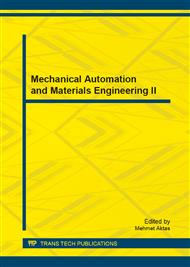[1]
Lin Y. K. Reliability of a computer network in case capacity weight varying with arcs, nodes and types of commodity[J]. Reliability Engineering and System Safety, 2007, 92(5): 646-652.
DOI: 10.1016/j.ress.2006.02.005
Google Scholar
[2]
Gunawan I. Redundant paths and reliability bounds in gamma networks[J]. Applied Mathematical Modeling, 2008, 32(4): 588-594.
DOI: 10.1016/j.apm.2007.01.003
Google Scholar
[3]
Gunawan I. Redundant paths and reliability bounds in gamma networks[J]. Applied Mathematical Modeling, 2008, 32(4): 588-594.
DOI: 10.1016/j.apm.2007.01.003
Google Scholar
[4]
Pan Yantao, Peng Wei, Lu Xicheng. The maximum flow algorithm [J]. Journal of National University of Defense Technology maximum lifetime for Sensor Networks, 2006, 28(3): 59-63.
DOI: 10.1109/wcica.2006.1713045
Google Scholar
[5]
Liu Aimin, Liu Youheng. Analysis of communication network service performance unreliable components [J]. Journal of Electronics, 2002, 30 (10): 1459-1462.
Google Scholar
[6]
Huangfu Wei, Rong Peng, who Lieguang. Analysis of survivability quantitative [J]. Journal of electronic SDH self-healing ring, 2001, 29(11): 1558-1560.
Google Scholar
[7]
Duan Moyi. A network node new validity index [J]. Journal of computer applications, 2012, 32 (7): 1796-17981803.
Google Scholar
[8]
Xu Ke, Xu Jinwu, Xiao. Forecasting of some classes of non-stationary time series wavelet decomposition method based on . electronic journal, 2001, 29 (4): 566-568.
Google Scholar
[9]
Wen Yong, Zhu Guangxi. The sliding of self-similar network traffic with the average prediction . Journal of Computer Science & technology, 2006, 33 (6): 32-34.
Google Scholar
[10]
Xin Wang, Yong Ren, Xiuming Shan. WDRLS: A wavelet-based on-Line predictor for network traffic. GLOBECOM, IEEE, 2003: 4034-4038.
DOI: 10.1109/glocom.2003.1258986
Google Scholar
[11]
Duan Moyi Calman filtering and data association based fusion algorithm based on [J]. computer applications, 2012, 32 (11): 3112-31143124.
Google Scholar
[12]
Walter Willinger. Self-similarity in wide-area network traffic. IEEE, 1997: 462-463.
Google Scholar
[13]
Wu Shaoxing, Zhang Geling, Ma Yujun. P2P routing algorithm [J]. Journal of computer engineering, immune clone annealing algorithm based on 2009, 35 (18): 198-199.
Google Scholar
[14]
Lu Lirong, for you, Huo Bingpeng. Simulated annealing algorithm [J]. based on immune programming computer engineering, 2007, 33 (19): 196-198.
Google Scholar
[15]
Liu Jinming, Wang Xinsheng, Liang Qingmei. QoS multicast routing algorithm for [J]. Computer Engineering, based on genetic simulated annealing algorithm 2007, 33 (9): 212-215.
DOI: 10.1109/iccasm.2010.5619175
Google Scholar
[16]
Duan Moyi. Computer engineering and design of network survivability of [J]. immune clone based on simulated annealing algorithm, 2012, 32 (12): 4436-4439.
Google Scholar


